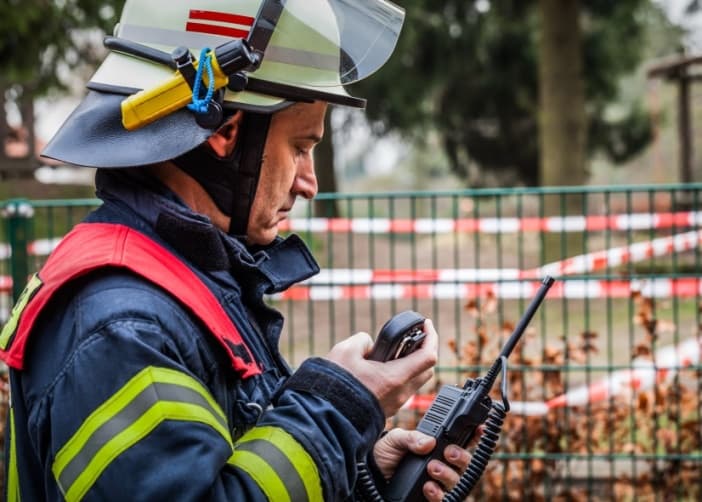Two-way radios, renowned for their sturdy build and user-friendly functionality, are indispensable tools in emergencies. They provide a reliable lifeline for communication, especially when traditional communication networks are compromised or fail.
This immediacy is crucial for emergency responders, businesses, and individuals, enabling swift decision-making and coordination to save lives and mitigate damage.
The article delves into the critical role of two-way radios in emergency preparedness, emphasizing their resilience, user-friendliness, and pivotal function in maintaining effective communication during emergencies.

Durability And Reliability
Two-way radios are engineered to withstand harsh conditions, making them indispensable in emergencies. Unlike standard communication devices, they are often built to military and IP specifications, ensuring they remain operational in extreme environments.
Companies that buy and sell radios, like Sell Radios, often emphasize this aspect, ensuring users are aware of the superior durability and reliability these devices offer.
This durability is crucial, especially when dealing with natural disasters like floods, earthquakes, or wildfires, where typical communication tools might fail. Reliability is another hallmark of these devices.
In scenarios where cellular networks are overloaded or non-existent, two-way radios operate effectively. Their ability to function in ‘dead zones’ or areas with poor cellular coverage is critical to emergency preparedness, ensuring uninterrupted communication channels are always available.
Ease of Use And Accessibility
One of the most significant advantages of two-way radios is their ease of use. In high-stress emergency situations, simplicity in operation becomes a key factor.
These radios offer straightforward, push-to-talk functionality, which is easy for anyone to use, regardless of their technical expertise. This accessibility ensures that individuals can communicate effectively during emergencies without extensive training.
Furthermore, two-way radios are designed to be user-friendly, with features like voice-activated transmission and clear audio quality. These features help to reduce misunderstandings and ensure clear communication, which is critical when relaying important information during emergencies.
Speed And Efficiency of Communication
The speed at which information is relayed can make a significant difference in emergencies. Two-way radios excel in providing immediate communication, unlike cell phones or other devices that may require dialing and connecting.
The instant push-to-talk feature ensures messages are sent and received promptly, which is paramount in time-sensitive situations. Moreover, two-way radios allow for group communication, enabling one message to reach multiple recipients simultaneously. This efficiency is vital in coordinating efforts during emergencies, where disseminating information quickly to a group is often necessary.
Cost-Effectiveness And Availability
Two-way radios are a cost-efficient solution, especially for organizations that need to equip multiple personnel. Compared to the recurring costs associated with cell phone plans, two-way radios require a one-time investment, making them a more economical choice for many.
Additionally, the availability of these radios is noteworthy. They can be easily acquired from various suppliers, including specialized companies that sell radios specifically designed for emergency preparedness.
This accessibility ensures that organizations and individuals can use this vital communication tool without facing significant barriers.
Long-Range Communication Capabilities
Two-way radios are not just limited to short-range communication. Many models offer long-range capabilities, which are essential in widespread emergency scenarios.
Whether it’s coordinating relief efforts across a large area or maintaining contact in remote locations, these radios provide a reliable means of long-distance communication.
Communication over long distances is especially valuable in rural or remote areas with non-existent or limited cellular coverage. In such scenarios, two-way radios become the lifeline, connecting people and facilitating coordinated efforts across vast distances.

Integration with Other Emergency Systems
An often-overlooked aspect of two-way radios is their ability to integrate with other emergency systems. Many models can be connected to public address systems, sirens, or other alert systems, enhancing their utility in emergencies. This integration allows for broader communication reach, ensuring that alerts and instructions can be disseminated quickly and efficiently to a larger audience.
Moreover, some two-way radios are equipped with advanced features like GPS tracking, which can be invaluable in search and rescue operations. Integrating these features with emergency protocols enhances overall response effectiveness, providing a cohesive and coordinated approach to emergency management.
Training And Preparedness
While two-way radios are a step in the right direction, training and preparedness are equally important. Regular training sessions ensure that individuals and teams are proficient in using these radios, understand their features, and can effectively communicate during emergencies. This preparedness is not just about handling the equipment but also about understanding communication protocols and emergency procedures.
Furthermore, drills and simulations using two-way radios can significantly enhance readiness. These exercises help identify potential communication challenges and allow teams to refine their strategies, ensuring that when a real emergency occurs, they are well-prepared to use their communication tools effectively.
Takeaway
Two-way radios are indispensable tools in the domain of emergency preparedness. Their durability, ease of use, efficiency, cost-effectiveness, and range make them ideal for ensuring robust communication during crises.
Integrating these devices with other emergency systems and the importance of proper training highlights their comprehensive role in emergency management.
As the unpredictability of emergencies continues to challenge communities and organizations, the reliance on two-way radios as a primary communication tool remains a critical aspect of preparedness strategies.













